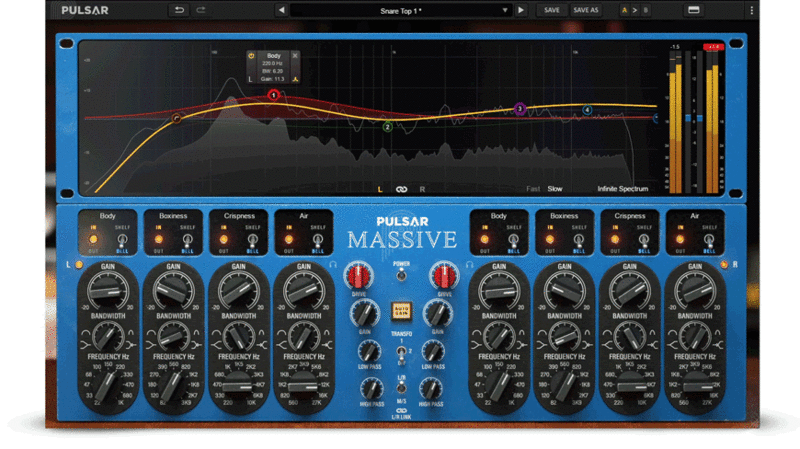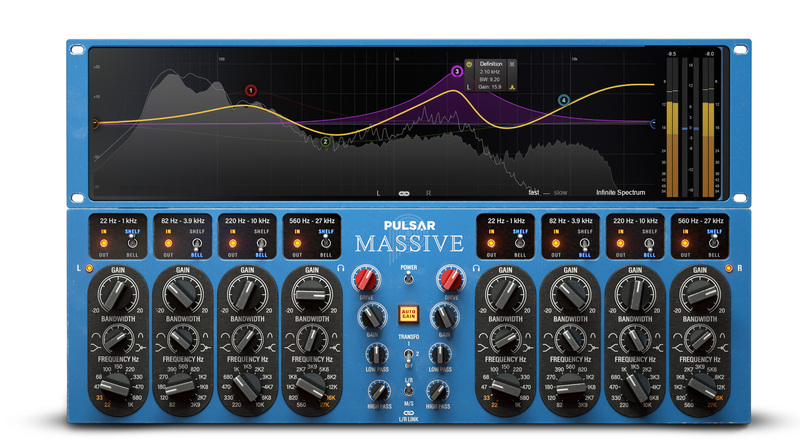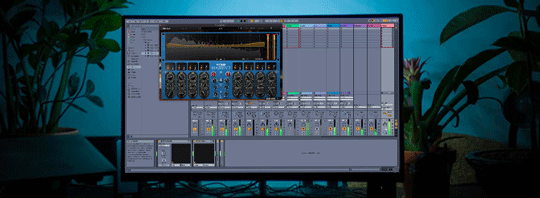- hot!
- top rated

"Pulsar Massive gives a whole new and more modern appeal to the sound even when used in the more ‘traditional’ boost/cut way – but it also adds the flexibility of actually sculpting sounds to their core in a super musical way"Andrei Lepori. Producer, Mixing Engineer

"This eq is incredibly cool! It gives you the vibe and sonics of an analog EQ, but you can also control it like a modern slick digital EQ, taking full advantage of the digital power!"John Nathaniel. Producer, Composer, Mixer
A Different Equalizing Experience
The most complete passive EQ plugin. Musical and intuitive, a must-have for mixing and mastering.
Pulsar Massive is an emulation of a legendary analog EQ that is present in almost every mastering studio in the world. This machine was designed as a synthesis of the best passive equalizers of the last 70 years, and several distinct features in the design give it an absolutely unique sound.
First of all, the fully parallel topology of the EQ gives a completely different kind of response to a digital equalizer with the same settings. A parallel equalizer’s tonal corrections aren’t cumulative but tend to interact with each other, resulting in a more intuitive and fluid way to shape the frequency spectrum.
As well as this, the whole equalization circuit of the original hardware is passive and therefore has several inductors. These inductors, machined and wound specifically by the manufacturer, are responsible for a creamy, non-linear and organic sound due to the magnetic saturation they introduce.
Finally, the input, output, and internal gain stages are entirely tube and transformer operated, providing another step of warm and organic coloration.
Pulsar Audio's software meticulously reproduces all these important aspects of the original hardware, but also offers an interface inspired by its ergonomics, which were much appreciated by its users.
But Pulsar Audio have taken Massive even further, adding all the key features you would expect from a modern, versatile EQ plugin, including visual curve editing for a fast workflow and a drive parameter to push the inductor and tube saturation stages harder for more vibe.
Improving on a classic
Pulsar Massive comes with a complete on-screen curve editor and spectrum analyzer. This best-of-both-world approach gives an accurate overview of your EQ changes while highlighting the singular behaviors of the original unit. The easy-to-use graphic interface allows a fast and radical workflow for mixing applications.
The Drive control allows usage of the plugin at internal levels where the analog vibe of the original unit is unusual and musical. Pulsar Massive’s accurate models of transformers, tubes, and inductors produce large amounts of harmonics and non-linearities. All coupled together, these are responsible for the subtle, dynamic and program-dependent low-end compression beloved by generations of sound engineers.
Pulsar Massive is a component-accurate model of the original unit, perfectly emulating its parallel EQ design and the unique sound-sculpting feeling. With parallel EQ, band gains don’t accumulate as in most other EQs, but rather recombine to produce natural-sounding corrections. The Pultec-like low-shelf filters allow a generous and tight low end, even at extreme boost settings. The high-shelf filters provide a pristine top end and air without harshness.
Pulsar Massive takes full advantage of modern CPUs to do more with less. Despite the tremendous amount of complexity in the audio algorithms you’ll be able to use a large number of instances. The resizable interface and wise choice of modern features will make Pulsar Massive your go-to color-EQ.
How does it sound?
Smooth and musical
Just ask any experienced engineer to hear a ringing endorsement of passive EQ and its uses! Pulsar Massive’s sound can be described as giving a creamy top-end, well-balanced mids, and a punchy low-end. Whether you’re using subtle or extreme settings, audio never sounds over-equalized, but rather vivid and natural, keeping true to the nature of your source material.
For mastering
In mastering, Pulsar Massive is the perfect tool to add sparkle and heft to your mix. For instance, it’s often used to add power to the low end (47 or 68 Hz) while retaining dynamic separation and balance between kick and bass, or to add air (16 kHz high-shelf) without any harshness. Pulsar Massive is also mind-blowing when used in Mid/Side mode, for perfect control over the stereo scene.
On vocals
A creative and musical tool for lead vocals, Pulsar Massive is excellent for adding presence (with the 3.3kHz or 4.7kHz bell filters), and some low-mid warmth without any mud (with the 220Hz low-shelf for instance), thanks to the Bandwidth parameter. The 1.6kHz bell filter is magic to add or remove density, helping a vocal to sit in the mix. Don’t hesitate to really push the drive for some creamy saturation!
Mixing electric guitar
Saturated electric guitars are very busy in the midrange – especially in extreme musical styles, and this can make them difficult to mix. Because the human ear is very sensitive to spectrum and phase manipulation in these areas, Pulsar Massive, with its smooth parallel EQ curves and naturally gentler phase alteration, is the perfect tool for shaping tone without messing with the phase.
Working the drum bus
Whether it’s used for cleaning mud (a gentle bell cut at 180Hz), to tame harshness on overheads (a gentle bell cut at 2.2kHz), or to add brilliance (a gentle high-shelf boost at 8.2kHz), Pulsar Massive will bring a coat of polish to push your drums to the next level. To top it off, you can adjust how Pulsar Massive reacts to the transients of the kick and snare with the Drive control, for a customized dynamic response.
Electronic music
Pulsar Massive can be used as a sculpting tool for very rich sources like synth pads or synth basses. Use it in creative ways, experimenting with extreme curves and driving it hard – you won’t have to work hard to get great results. In addition, on a mixbus, choosing the right transformer will allow you to beef up your kick drum or keep it tight.
Features
- Visual curve editing
- Mid-Side processing
- Oversampling
- Metering & Spectrum analyser
- Drive control
- Auto-gain
- Transformer
- Smart GUI
System Requirements
Mac
- MacOS 10.9 and higher (M1 Apple Silicon supported) (64-bit only)
- CPU: Intel Core i3 / i5 / i7 / Xeon / Apple Silicon (M1)
- Memory: 4 GB RAM / 1 GB free disk space
- GPU: OpengGL 2.0 compatible GPU
- Monitor: Resolution: minimum 1024×768, recommended 1920×1080 / Refresh rate: 60 Hz
Windows
- Windows 7 with SP1 64 bit / Windows 8.1 64 bit / Windows 10 64 bit
- CPU: Intel Core i3 / i5 / i7 / i9 / Xeon or AMD Quad-Core minimum
- Memory: 4 GB RAM / 1 GB free disk space
- GPU: OpengGL 2.0 compatible GPU
- Monitor: Resolution: minimum 1024×768, recommended 1920×1080 / Refresh rate: 60 Hz
Compatible plugin formats
- AAX Native
- Audio Unit (AU)
- VST 2.4
- VST 3
Any references to any brands on this site/page, including reference to brands and instruments, are provided for description purposes only. For example references to instrument brands are provided to describe the sound of the instrument and/or the instrument used in the sample. Plugin Boutique do not have (nor do they claim) any association with or endorsement by these brands. Any goodwill attached to those brands rest with the brand owner. Plugin Boutique or its Suppliers do not accept any liability in relation to the content of the product or the accuracy of the description. "RHODES" is a registered trademark of Joseph A Brandstetter.





